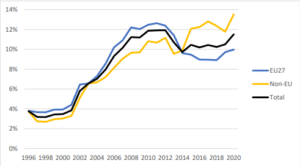Intersection of AI and Copyright : a groundbreaking Czech ruling
In an emblematic decision that underscores the complex relationship between artificial intelligence (AI) and copyright laws, the Municipal Court of Prague has set a precedent with potential far-reaching implications. This decision, one of the first of its kind in Europe, determined that an image generated by the AI tool DALL-E could not be copyrighted because it was not created by a natural person.
Background of the case
The case involved an unnamed claimant who used OpenAI’s DALL-E to generate an image for their website, with the prompt : “Create a visual representation of two parties signing a business contract in a formal setting, such as a conference room or a law firm office in Prague. Show only hands.” After the image was created and posted on the website, it was copied by a local law firm and used on their own website, presumably to illustrate a publication or message.
The claimant sought legal redress for copyright infringement, asserting authorship of the AI-generated image and requesting injunctive relief against the defendant.
Analysis of the decision
The crux of the court’s deliberation centered on the issue of authorship and whether an AI could be recognized as the author of a copyright work under existing legal frameworks. The Czech Copyright Act, particularly Article 40, recognizes the rights of the author, including the ability to challenge unauthorized use of their works. However, Article 5(1) of the Act specifies that the author is “the natural person who created the work.”
In this instance, while the claimant argued that the image was created under their instruction and thus, they were the rightful author, the court noted that the claimant had not provided sufficient evidence to substantiate this claim beyond their own testimony. Therefore, the claimant failed to meet the necessary burden of proof for establishing authorship and lacked the legal standing to pursue the claim.
Moreover, the court observed that the image, being the product of an Artificial Intelligence, did not fulfill the criteria of a work resulting from the creative activity of a natural person as required by the Act. Consequently, the image was not eligible for copyright protection.
Commentary
This ruling is not entirely unexpected given the current legal standards, but it does highlight several key considerations for the future of AI in creative domains. The court did not entirely dismiss the possibility that the plaintiff could be considered the author if sufficient evidence were presented. This opens up discussions on what could constitute sufficient evidence and the level of human involvement necessary for AI-generated works to qualify for copyright protection.
As AI technology continues to evolve and integrate more deeply into creative and commercial practices, this case sets a significant precedent. It emphasizes the necessity for artists, businesses, and legal professionals to consider alternative forms of protection, such as contracts, to safeguard their interests.
The decision also serves as a reminder of the urgent need for legislative bodies to revisit and possibly revise copyright laws to better accommodate the realities of AI-driven creativity. This is especially pertinent in Europe, where the integration of AI in various sectors is accelerating, necessitating clear legal frameworks that recognize and protect the contributions of both human and technological creations.
Dreyfus Lawfirm can offer expertise on Copyright and AI matters.
Join us on social media !











 Image generated by DALL-E
Image generated by DALL-E 



 Image generated by DALL E 3 Microsoft version
Image generated by DALL E 3 Microsoft version

